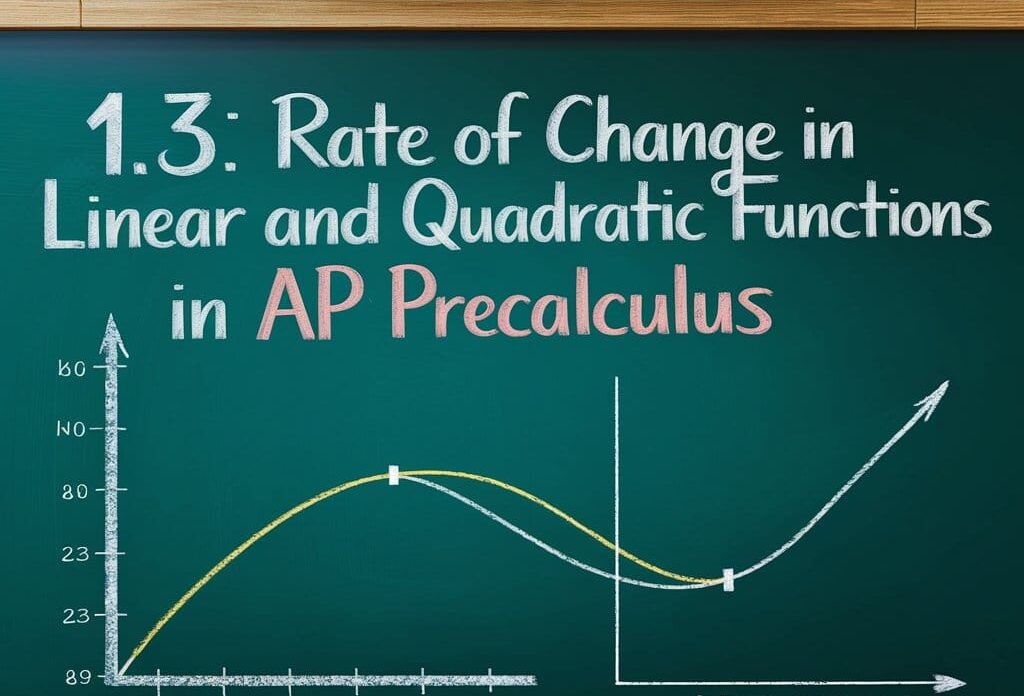Introduction and Recap
In the previous section, we explored how one quantity changes relative to another and saw how this concept applies to a variety of functions. We learned that the Average Rate of Change (AROC) is represented as the slope of a secant line connecting two points on a function, calculated using the formula:
![]()
.
This idea allowed us to analyze how functions behave over intervals, forming a bridge to deeper concepts in calculus, such as derivatives and integrals. We saw examples of linear functions, where the rate of change remains constant, and nonlinear functions, like quadratic ones, where the rate varies across intervals.
But rate of change is more than just formulas and calculations. It’s a tool for understanding relationships between variables, whether analyzing the slope of a graph or interpreting changes from a table of values. This foundation is essential as we learn the Rate of Change of Linear and Quadratic Functions, where we’ll extend these ideas to new heights.
In this section, we’ll explore:
- The behavior of rate of change in linear and quadratic functions.
- How to recognize the type of function from a table of input and output values.
- The significance of first and second differences in analyzing functions.
- Techniques to determine missing constants in tables using slope or difference methods.
- How to identify the concavity of a function from data.
Linear and Quadratic Functions
Linear and quadratic functions are two of the most fundamental types of functions in mathematics, each with distinct characteristics and applications.
Linear Functions
A linear function has the form:
![]()
where ![]() represents the slope (rate of change) and
represents the slope (rate of change) and ![]() is the y-intercept.
is the y-intercept.
Key Characteristics:
- The graph of a linear function is a straight line.
- The rate of change, or slope, is constant across all intervals.
- Example: For
 , the slope
, the slope  indicates that the function increases by
indicates that the function increases by  units for every 1-unit increase in
units for every 1-unit increase in  .
.

Quadratic Functions
A quadratic function has the form:
![]()
where ![]() ,
, ![]() and
and ![]() are constants, and
are constants, and ![]() .
.
Key Characteristics:
- The graph of a quadratic function is a parabola, which may open upwards
 or downwards
or downwards  .
. - The rate of change varies across intervals, increasing or decreasing depending on the direction of the curve.
- Example: For
 , the parabola opens upwards, and the rate of change increases as
, the parabola opens upwards, and the rate of change increases as  moves further from the vertex.
moves further from the vertex.

Average Rate of Change: Linear vs. Quadratic Functions
The Average Rate of Change (AROC) helps us understand how a function behaves over a specific interval by measuring how much the output (y-value) changes relative to the input (x-value). This concept plays out differently in linear and quadratic functions.
For Linear Functions
In a linear function, the rate of change is constant, regardless of the interval chosen. The slope m of the line itself represents the average rate of change.
Example:
Consider the linear function ![]() over the interval
over the interval ![]() :
:
- At
 ,
,  .
. - At
 ,
,  .
.
![]()
As expected, the average rate of change equals the slope, ![]() .
.

For Quadratic Functions
In a quadratic function, the rate of change varies depending on the interval, as the graph is curved. This variability is reflected in the changing slopes of the secant lines connecting two points on the curve.
Example:
Consider the quadratic function ![]() over the interval
over the interval ![]() :
:
- At
 ,
,  .
. - At
 ,
,  .
.
![]()

Unlike linear functions, the average rate of change for a quadratic function depends on the specific interval chosen.
Recognizing Linear, Quadratic, or Neither
When working with tables of input ![]() and output
and output ![]() values, identifying the nature of the underlying function—linear, quadratic, or neither—is essential. This can be achieved by analyzing the patterns in the differences between successive y-values.
values, identifying the nature of the underlying function—linear, quadratic, or neither—is essential. This can be achieved by analyzing the patterns in the differences between successive y-values.
First Differences: Identifying Linear Functions
The first differences are the differences between consecutive y-values in the table. For a function to be linear:
- The first differences must be constant.
Example:
| x | y | First Difference |
|---|---|---|
| 1 | 3 | — |
| 2 | 7 | 7 – 3 = 4 |
| 3 | 11 | 11 – 7 = 4 |
| 4 | 15 | 15 – 11 = 4 |
Since the first differences are constant ![]() , the function is linear.
, the function is linear.
Second Differences: Identifying Quadratic Functions
For quadratic functions, the second differences—the differences of the first differences—must be constant.
Example:
| x | y | First Difference | Second Difference |
|---|---|---|---|
| 1 | 2 | — | — |
| 2 | 5 | 5 – 2 = 3 | — |
| 3 | 10 | 10 – 5 = 5 | 5 – 3 = 2 |
| 4 | 17 | 17 – 10 = 7 | 7 – 5 = 2 |
Here, the second differences ![]() are constant, confirming that the function is quadratic.
are constant, confirming that the function is quadratic.
Neither Linear Nor Quadratic
If neither the first nor the second differences are constant, the function is likely neither linear nor quadratic.
Example:
| x | y | First Difference | Second Difference |
|---|---|---|---|
| 1 | 1 | — | — |
| 2 | 3 | 3 – 1 = 2 | — |
| 3 | 8 | 8 – 3 = 5 | 5 – 2 = 3 |
| 4 | 18 | 18 – 8 = 10 | 10 – 5 = 5 |
Here:
- The first differences are 2, 5, 10, which are not constant (hence not linear).
- The second differences are 3, 5, which are also not constant (hence not quadratic).
Since neither difference is constant, the function is neither linear nor quadratic.
Click here to download the AP Precalculus Worksheets to increase your grades by practicing more!
Concavity of a Function Using Input-Output Tables
The concavity of a function describes the direction of its curvature—whether the graph of the function bends upwards (concave up) or downwards (concave down). This can be analyzed using the second differences in a table of input ![]() and output
and output ![]() values.
values.
Concave Up
A function is concave up if the second differences are positive. This indicates that the rate of change (slope) is increasing as x increases.
Example:
| x | y | First Difference | Second Difference |
|---|---|---|---|
| 1 | 2 | — | — |
| 2 | 5 | 5 – 2 = 3 | — |
| 3 | 10 | 10 – 5 = 5 | 5 – 3 = 2 |
| 4 | 17 | 17 – 10 = 7 | 7 – 5 = 2 |
Here, the second differences ![]() are positive, showing the function is concave up.
are positive, showing the function is concave up.
Concave Down
A function is concave down if the second differences are negative, meaning the rate of change (slope) is decreasing as x increases.
Example:
| x | y | First Difference | Second Difference |
|---|---|---|---|
| 1 | 20 | — | — |
| 2 | 15 | 15 – 20 = -5 | — |
| 3 | 10 | 10 – 15 = -5 | (-5) – (-5) = 0 |
| 4 | 0 | 0 – 10 = -10 | (-10) – (-5) = -5 |
Here, the second differences ![]() are negative, showing the function is concave down.
are negative, showing the function is concave down.
Finding a Missing Constant in a Table
In some cases, tables of input-output values may have a missing constant, and you’re required to find it using the slope method or the difference method based on the type of function (linear, quadratic, or other).
Using the Slope Method for Linear Functions
For linear functions, the rate of change (slope) is constant across all intervals.
Steps:
- Identify the known points in the table.
- Use the formula for slope:
![Rendered by QuickLaTeX.com \[\text{slope}=\frac{y_2-y_1}{x_2-x_1}\]](data:image/svg+xml;base64,PHN2ZyB4bWxucz0iaHR0cDovL3d3dy53My5vcmcvMjAwMC9zdmciIHdpZHRoPSIxMjMiIGhlaWdodD0iMzQiIHZpZXdCb3g9IjAgMCAxMjMgMzQiPjxyZWN0IHdpZHRoPSIxMDAlIiBoZWlnaHQ9IjEwMCUiIHN0eWxlPSJmaWxsOiNjZmQ0ZGI7ZmlsbC1vcGFjaXR5OiAwLjE7Ii8+PC9zdmc+)
- Substitute the known values and solve for the missing constant.
Example:
| x | y |
|---|---|
| 1 | 3 |
| 2 | ? |
| 3 | 7 |
Let the missing value at ![]() be
be ![]() .
.
- The slope between
 and
and  is constant:
is constant: 
- Solving:

The missing value is ![]() .
.
Looking for some reliable resources? Read top 10 books for AP Precalculus.
Using the First and Second Difference Method for Quadratic Functions
For quadratic functions, the second differences are constant.
Steps:
- Calculate the first differences
 and identify the missing value.
and identify the missing value. - Calculate the second differences
 to ensure consistency.
to ensure consistency. - Solve for the missing constant.
Example:
| x | y | First Difference | Second Difference |
|---|---|---|---|
| 1 | 2 | — | — |
| 2 | ? | ? – 2 | — |
| 3 | 8 | 8 – ? | (8 – ?) – (? – 2) |
| 4 | 14 | 14 – 8 = 6 | 6 – (8 – ?) |
Let the missing value at ![]() be
be ![]() .
.
- First differences:

- Second differences:

- Equating second differences:

The missing value is ![]() .
.
Check out the official College Board website to have a deeper overview of AP Precalculus!
Need personalized guidance? Book a private online AP Precalculus tutor now!



